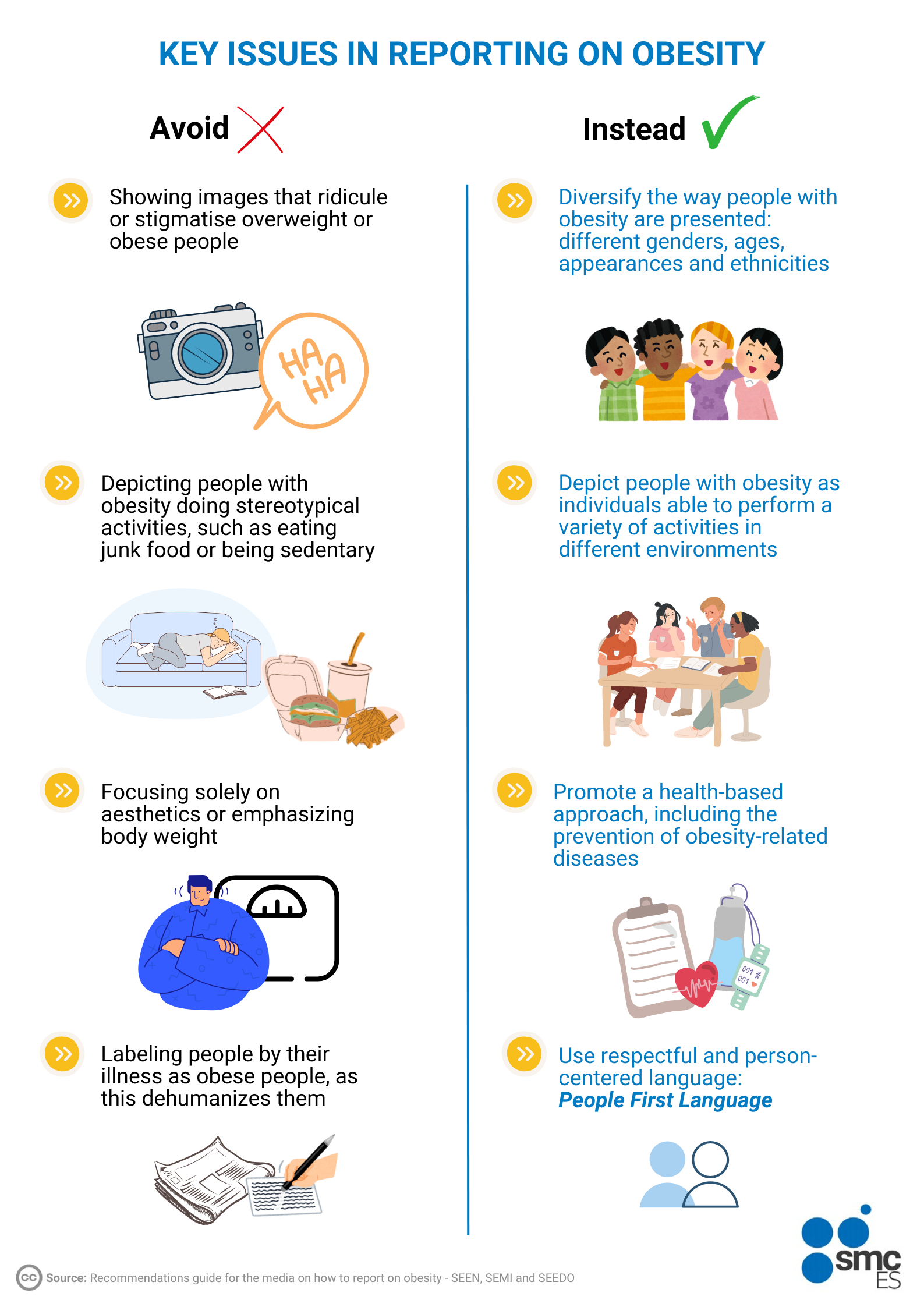What are the main mistakes that appear in the media when it comes to obesity?
‘On many occasions, the media reduce obesity to the idea that it is only caused by eating too much and moving too little," Javier Butragueño, PhD in Physical Activity and Sport Sciences and member of the Spanish Obesity Society (SEEDO), explains to SMC España. Added to this is ‘the use of stigmatising language, which reinforces prejudices and associated discrimination,’ he says.
Lilliam Flores, endocrinologist at the Obesity Unit of the Endocrinology and Nutrition Service of the Hospital Clínic de Barcelona and former SEEDO spokesperson, agrees with both points and adds that ‘many messages attribute the cause of obesity entirely to personal responsibility, ignoring more complex biological, social and environmental factors’. She also explains to SMC another of the main errors: ‘The negative visual representation that reinforces existing prejudices and the oversimplification of the problem’.
Which facets of obesity are underrepresented in the media?
‘The media often fail to address obesity as a medical condition that requires long-term professional follow-up and treatment,’ says Flores. ‘Nor do they often provide sufficient information on prevention strategies and health education related to obesity,’ she stresses.
In addition, ‘mental health problems that are often linked to obesity, such as anxiety, depression or eating disorders (binge eating disorders), are hardly visible,’ says Butragueño.
How does this representation of obesity affect those who suffer from it?
‘The stigmatising representation creates a negative cycle that can worsen the condition of obesity and hinder its effective treatment,’ explains the endocrinologist at Hospital Clínic. ‘This leads many people to postpone or avoid seeking professional help for fear of social judgement, resulting in late diagnosis and a worsening of their health,’ adds the SEEDO member.
In addition, both professionals highlight the impact on the mental health of people living with obesity. ‘They experience higher rates of depression, anxiety, low self-esteem and eating disorders as a result of stigma,’ summarises Flores.
What imaginary of obesity can be generated by such media coverage?
‘Media coverage that reduces obesity to a matter of individual will and associates it with lazy or gluttonous behaviour generates a moralising vision that tends to blame those who suffer from it,’ explains Butragueño. Likewise, the simplistic narrative ‘trivialises the clinical relevance of the disease, presenting it as a merely aesthetic problem rather than as a risk factor for multiple pathologies such as cardiovascular and metabolic diseases,’ he says.
What mistakes should journalists focus on, and how can they be reversed?
‘It is essential that journalists review their language and avoid pejorative or sensationalist terms that reduce obesity to a mere character flaw,’ says the SEEDO member. He also stresses the importance of sources: ‘It is essential that they are supported by scientific evidence’.
Lilliam Flores explains how these errors can be corrected. As for the lexicon, the endocrinologist explains that ‘respectful and precise language should be used, referring to people with obesity instead of other labels’. As for sources, she points to the preference for the use of ‘specialised sources, not just institutional ones’.
In addition, she stresses the adoption of ‘a collective responsibility approach, considering social, environmental and political factors’. ‘We must provide balanced coverage that addresses the complexity of obesity as a public health problem,’ she adds.
Butragueño proposes ‘complementing this vision with testimonies from the people affected themselves or from patient associations’. ‘In this way, a comprehensive and human approach is provided that favours the understanding of the disease,’ he says.

How should a correct graphic coverage be made to illustrate this disease?
When selecting images, it is crucial to avoid those that show only body parts, such as torsos or headless buttocks, says Butragueño. ‘They dehumanise the person and reinforce negative stereotypes.
For her part, Flores points out that ‘respectful representations should be used, showing people with obesity carrying out normal daily activities, without focusing exclusively on their weight’. She also stresses the need to ‘include images of people of different ages, genders and ethnicities to reflect the diversity of those living with obesity’.
Among other useful resources, the endocrinologist recommends the use of educational graphic tools, such as information graphics that help to better understand the disease or that represent obesity statistics and trends in a clear and objective way.
Is there unity in the recommendations of national, European and global scientific and medical societies?
Yes, ‘among the main scientific and medical societies, both national and international, there is a consensus on the need to use respectful and person-centred language - People First Language- moving away from expressions that perpetuate stigma’, explains Butragueño.
In addition, a large majority of these societies express the same objectives and recommendations regarding news coverage of obesity, which are in line with those developed by both SEEDO experts.
What resources can journalists draw on to address obesity?
Both professionals emphasise and recommend consulting the style guides and codes of ethics drawn up by the different national and international medical scientific organisations and societies. Among these resources we can find:
- Guide of recommendations for the media on how to report on obesity. Spanish Society of Endocrinology and Nutrition (SEEN), Spanish Society of Internal Medicine (SEMI) and Spanish Society of Obesity (SEEDO).
- Guide to person-centred language. Spanish Obesity Society (SEEDO) and European Association for the Study of Obesity (EASO).
- Recommendations for the media. World Obesity Federation.
- Resources for journalists. The Obesity Society (TOS).
- Media support. European Association for the Study of Obesity (EASO).
- Guidelines for media portrayals of people affected by obesity. Obesity Action Coalition.
- A guide for media and communications professionals: Changing the obesity narrative. Australian Government Department of Health.
Butragueño recalls the possibility of ‘seeking advice from professionals specialised in the field, such as SEEDO working groups, endocrinologists, nutritionists, psychologists or trainers’.
‘Continuous training in health and science - through courses, seminars or webinars - is key for journalists to improve their skills and adjust their informative work to the needs of rigour and empathy demanded by the treatment of obesity,’ he adds.
Along these lines, SEEDO organised the 1st Conference on Journalism and Obesity in Cuenca on 24 and 25 January, in which communication professionals were offered resources and keys to improve media coverage of the disease.
Are there graphic resources?
Yes, many organisations have specialised image banks for the correct graphical representation of obesity. Here are some of them.
- Obesity Action Coalition (OAC) image gallery.
- The World Obesity Image Bank.
- European Association for the Study of Obesity (EASO) Image Bank.
- European Coalition for People living with Obesity (ECPO) Image Bank.
- Obesity Canada Image Bank.
- Media Gallery UCONN Rudd Center for Food Policy and Health.




